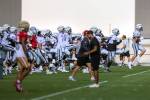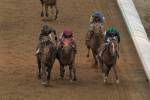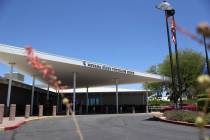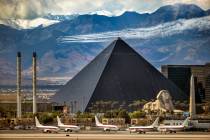Red Flag exercises push pilots, crews to their limits
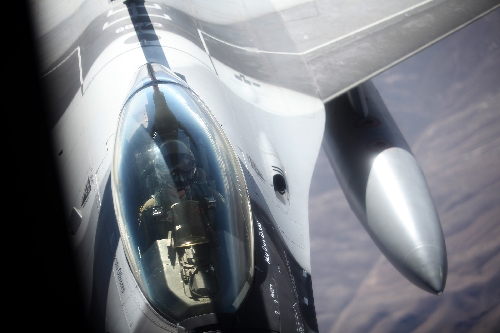
A sudden swoosh followed by an ear-splitting roar from the fighter jet’s engines shattered the silence along the sun-drenched runway.
A gray F-15 Eagle lifted off the concrete, then disappeared in a blink, flying high over the northern horizon with its twin afterburners aglow.
The thunderous wake, or "sound of freedom" as aviation buffs call it, signaled the start of another Red Flag day, a chance for U.S. pilots and their coalition partners to work on defeating a would-be enemy in the oft-held training exercise at Nellis Air Force Base.
Just as Wednesday was another day for the pilots, it was another day for the team that keeps them flying.
They are the folks who run the gas station in the sky for the jets to refuel while cruising at 400 mph over the vast Nevada Test and Training Range, the controllers in the tower who make sure the planes don’t run into each other when they launch and land in one of the nation’s most congested airspaces, and the seasoned veterans of the rescue squadrons who make sure the pilots will be picked up if the unthinkable happens.
It’s a drill they practice all the time, one they’ve performed for real on the battlefields of Iraq and Afghanistan.
"This is an entire team effort to put on an exercise the magnitude of Red Flag," said Col. Tod R. Fingal, commander of the 414th Combat Training Squadron at Nellis.
"Every person who walks through the door gets trained to an intensity that’s often more than the extent in combat."
EAST VERSUS WEST
The war game pits a Red Team of aggressors flying camouflage-painted F-15 Eagles and F-16 Fighting Falcons against the Blue Team’s jets, bombers and attack planes. The Blue Team usually has a larger force and operates out of the east side of the range. The "enemy" Red Team defends its missile sites, tanks and anti-aircraft targets while swarms of camo-jets launch attacks from the west.
Pilots are scored on video recordings of their bomb drops and electronic detection of their missile hits. The exercise is replayed at debriefings so pilots can grasp lessons learned and advance to the next level.
In this exercise, which runs through Friday, fighter jets from Colombia and United Arab Emirates join in the fray, two of 29 foreign countries that have been partners in Red Flag since it began in 1975.
The benefit of doing this is "so we know how to mix our forces to achieve coalition air dominance," Fingal said.
In all, 70 warplanes ascend from the crowded Las Vegas airspace to the restricted, 12,000-square-mile range where B-1 and B-52 bombers unleash a barrage of ordnance.
Jets strike makeshift missile sites and engage in dogfights and electronic jamming maneuvers. At any time, billions of dollars of assets are in the air, ranging from expensive fighter jets to not-so-costly unmanned spy planes to monstrous refueling tankers. And then there’s the E-3 AWACS, short for Airborne Warning and Control System, a converted jetliner topped with its signature 5-ton circular radar dome.
"We are training in space and the cyberspace domain," Fingal noted.
The Air Force will spend millions of dollars on the exercise – the exact amount wasn’t available Friday – before it ends this week and the 1,700 U.S. and coalition personnel return to their bases throughout the United States and the world.
Red Flag was instituted at the end of the Vietnam War to improve the 2-to-1 kill ratio U.S. pilots suffered going against MiGs and heat-seeking missiles.
Pentagon officials have repeatedly made the case that the money spent on training is necessary to maintain air superiority.
GAS STATION IN THE SKY
Most of the aircraft consume more fuel than it takes to fly them on long-distance sorties on a single tank. As such, they need to refuel while the battle wages on.
"We do a good job of keeping them separate. Our objective is to make sure the aggressors get their fuel on time," said Maj. Brian Ewasko, commander of the 92nd Air Refueling Wing from Fairchild Air Force Base near Spokane, Wash.
Ditto that for the Blue Team.
As Fingal pointed out, the exercise is so competitive that Red Team members have been known to "go to the extent of jumping into trash cans to get information on the Blue the day before."
On Friday, pilots for the Red Team’s KC-135 Stratotanker cruised through the thin air at more than 20,000 feet. Their job was to drive the boom operator to work.
From a prone position in the "boom pod" at the back end of the Stratotanker, he rested his chin on a pad while he gripped a joystick and watched through a Plexiglas enclosure for jets to zip in like hummingbirds and sip aviation fuel from a 20-foot-long pipe.
As the tanker and the aggressor jet nudge within 50 feet of each other, the operator extends the boom so it latches to a fuel port near the fighter jet’s canopy.
Making the hookup is a knack that demands concentration.
The boom operator, Master Sgt. Pat Ingram, of the 64th Air Refueling Squadron at Pease Air National Guard Base, N.H., said the biggest thing on his mind while trying to extend the boom to the fuel port, "is being aware of the receiver and what’s going on around you."
"You’re listening to different radios and you’re listening to all receivers coming in and going out. Your primary focus is listening to the receiver you’re doing the boom with. That’s the most unsafe thing we’re doing at that time," he said Friday while refueling F-16 aggressor jets from Nellis.
He said his biggest challenges are "the weather, turbulence stuff like that at night when you’re thinking a little harder because you lose your depth perception. It’s a lot tougher at night."
JUGGLING THE AIR SPACE
In a control tower on the Sunrise Mountain side of the Nellis runways, Senior Master Sgt. Chesley Vansickle watches over a crew of seven controllers.
While their eyes scan for incoming aircraft, they calmly talk to pilots from headsets in a jargon that translates to "watch out for the news helicopters heading for Apex," and, there’s a "Janet," an unmarked passenger jet, heading north shuttling workers to a classified location along the dry Groom Lake bed.
Things can get busy when 70 warplanes land or takeoff within an hour. Wednesday was no exception.
This wasn’t Vansickle’s first Red Flag. At 37, he has battled before for the precious air space to the south that Nellis shares with traffic approaching McCarran International Airport and the busy North Las Vegas Airport, 11 and seven miles away, respectively.
"When the weather comes in, that piece of airspace becomes a hot commodity," said the Memphis, Tenn., native.
He talked about the language barrier that controllers must overcome when communicating with foreign pilots.
All coalition pilots are required to comprehend English. Conveying it over the radio, though, with French-speaking pilots is sometimes more of a challenge.
Vansickle said the controllers range in age from 18 to 40. To handle the stress, they typically are low-key. "What does come with age is experience. It tends to make for better decisions."
THAT OTHERS MAY LIVE
To enter the hangar where the 66th Rescue Squadron resides at the Nellis base, visitors walk past a memorial for those who made the ultimate sacrifice.
Among the names is Capt. David "Wiz" Wisniewski, the 31-year-old pilot from Iowa who died from injuries in 2010, more than three weeks after his Pave Hawk helicopter crashed in a hail of rocket-propelled grenade fire while trying to rescue soldiers in Afghanistan.
Two other Nellis airmen were killed in the crash: 1st Lt. Joel C. Gentz, 25, of Grass Lake, Mich., and Staff Sgt. David C. Smith, 26, of Eight Mile, Ala., as well as two other pararescue men from Davis-Monthan Air Force Base in Arizona.
They knew the risks involved with their work.
"At the end of the day, we train for all of this that others may live," Lt. Col. Carlos Brown said, reciting the motto of Air Force rescue teams.
When the Jolly Greens, as they are known, returned from Iraq in February, they upheld their reputation as being the first ones in and the last to come home.
After their deployment nine years ago during the U.S.-led invasion of Iraq, the 66th from Nellis, along with their partners in the 58th and four other squadrons, saved 144 lives of U.S. and coalition troops and Iraqi citizens.
Their speciality, though, is bringing back downed pilots and crews who eject to survive shoot downs and ill-fated mechanical breakdowns. They practice this at Red Flag.
"We realize the importance of inserting special operations forces," Fingal said.
As such, he dispatched two pilots to act as downed crew members with classified information who had to be found and rescued before enemy soldiers captured them. The drill is called SERE for Survival, Evasion, Resistance, Escape.
Long before that first, gray F-15 headed out to the range, the rescue team was packing their gear, loading their carbines too, just like they would in a combat zone.
In case anything happened they could get to some of the farthest reaches of the range in about 40 minutes, depending on the load and the wind. They vowed to complete the mission "that others may live."
And, they’ll be the last to leave when Red Flag ends Friday.
Contact reporter Keith Rogers at krogers@reviewjournal.com or 702-383-0308.



